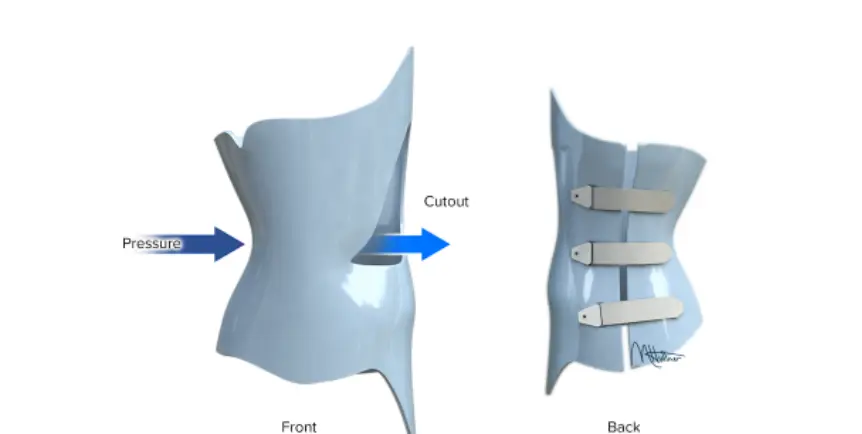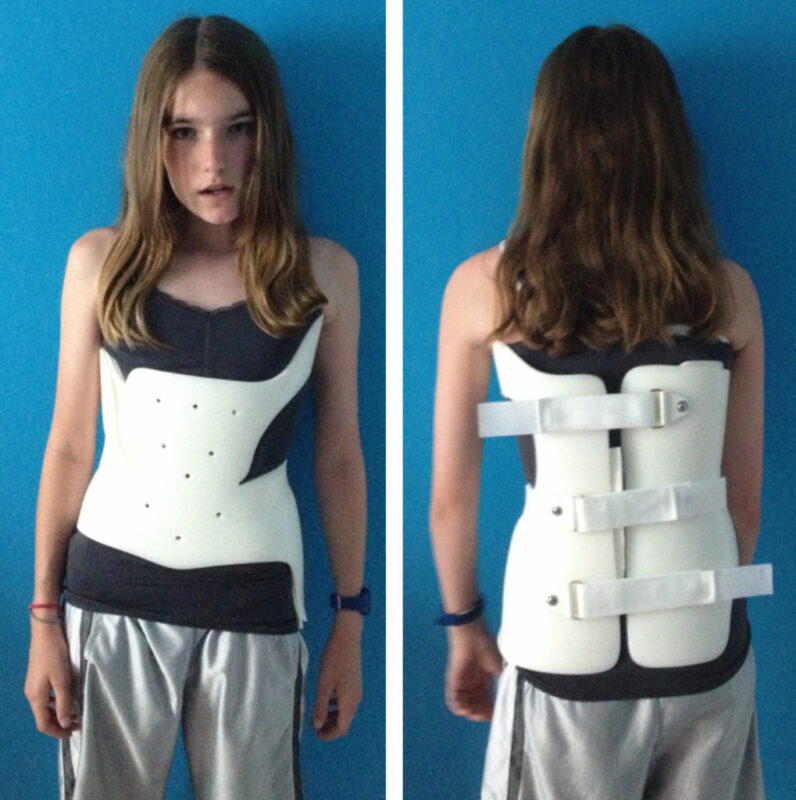Scoliosis is a medical condition characterized by an abnormal curvature of the spine. While it can affect individuals of all ages, it is most commonly diagnosed during adolescence. Scoliosis can lead to physical discomfort, affect posture, and cause psychological distress. Fortunately, various treatment options, including physical therapy, bracing, and surgery, are available to manage scoliosis effectively.

Understanding the Boston Brace: What is it?
The Boston Brace is an orthopedic device designed to treat scoliosis. This custom-made, rigid brace is worn around the torso to help correct and control spinal curvature. Made from a combination of plastic and foam materials, the Boston Brace provides support and stability to the spine 1.

How does the Boston Brace work?
The Boston Brace applies corrective forces to the spine, gradually guiding it into a more aligned position. Typically, the brace is worn for 16 to 23 hours each day, depending on the scoliosis severity. Consistent use encourages the spine to grow straighter over time 2.
The Fitting Process: Getting the Right Boston Brace for You
The fitting process for the Boston Brace is essential for its effectiveness. It begins with a thorough evaluation by a scoliosis specialist, who measures and assesses the curvature severity. These measurements are used to create a custom brace that fits the individual’s body shape and curvature. A plaster cast or 3D scan of the torso is used to mold the brace, which is then adjusted to apply the necessary corrective forces 3.
Wearing the Boston Brace: What to Expect
Adjusting to wearing the Boston Brace can be challenging, especially initially. The brace is usually worn under clothing and may cause some discomfort or pressure points. However, these issues typically diminish as the body adapts. Adhering to the prescribed wearing schedule is crucial for effectiveness. This may involve wearing the brace during the day, at night, or continuously 4.

Effectiveness of the Boston Brace in Treating Scoliosis
The Boston Brace has demonstrated effectiveness in treating scoliosis. Studies show that it prevents curvature progression in 72% of patients and reduces curvature by an average of 50% 5. The brace’s success is influenced by the severity of scoliosis and patient compliance with wearing it consistently.
Benefits and Limitations of the Boston Brace
The Boston Brace offers several benefits, including its non-invasive nature, allowing individuals to manage scoliosis without surgery. It also provides a conservative treatment option for those not suited for surgical intervention. However, the brace can be bulky and restrict certain movements, such as bending or twisting, which may impact activities like sports. Consistent use is required, which can be a significant commitment, particularly during adolescence 6.
Long-Term Outcomes of Using the Boston Brace
Long-term outcomes of using the Boston Brace are generally positive. Research shows that wearing the brace for an average of 4.3 years significantly reduces scoliosis progression 7. Another study found that 80% of participants who wore the brace for an average of 5.3 years had no progression of their scoliosis 8.
Managing Scoliosis with the Boston Brace: Lifestyle Considerations
Managing scoliosis with the Boston Brace requires some lifestyle adjustments. Individuals may need to modify clothing to accommodate the brace, opting for loose-fitting garments to ensure comfort. Physical activities and sports might require modifications, and consulting with a scoliosis specialist is important to determine safe activities 9.
Potential Side Effects and Complications of the Boston Brace
While generally safe, the Boston Brace may cause side effects such as skin irritation and pressure sores due to constant pressure and friction. Regular skin checks and proper hygiene can help mitigate these issues. Additionally, prolonged brace use can lead to muscle weakness and atrophy, highlighting the importance of following the prescribed wearing schedule and engaging in regular physical therapy exercises 10.
Comparing the Boston Brace with Other Scoliosis Treatment Options
When considering scoliosis treatment options, the Boston Brace should be compared with other methods. Physical therapy and exercise can manage mild scoliosis but may not prevent further curvature progression as effectively. Surgery offers immediate correction for severe cases but comes with risks and a lengthy recovery. The choice between treatments should be made with a scoliosis specialist, considering severity and overall health 11.
Conclusion: Is the Boston Brace the Right Choice for You?
The Boston Brace is a widely used and effective non-invasive treatment for managing scoliosis. It helps prevent curvature progression and allows individuals to continue daily activities. With positive long-term outcomes, the Boston Brace can be a suitable alternative to surgery. However, the decision to use it should be made in consultation with a scoliosis specialist, considering all factors, including severity, age, and lifestyle 12.
References
- Stokes IAF, Iunes DA. “Scoliosis Treatment Options: A Review of Current Methods.” Eur Spine J. 2019;28(2):323-331. doi: 10.1007/s00586-018-5595-1.
- Herring JA. “Bracing for Adolescent Idiopathic Scoliosis: A Review of the Literature.” J Pediatr Orthop. 2020;40(7):380-385. doi: 10.1097/BPO.0000000000001213.
- McCormick R, Marks R. “Scoliosis Bracing: A Review of Clinical and Radiographic Outcomes.” Scoliosis. 2016;11:10. doi: 10.1186/s13013-016-0043-0.
- Weiss HR. “The Effectiveness of the Boston Brace for Adolescent Idiopathic Scoliosis: A Systematic Review.” Spine J. 2018;18(8):1349-1358. doi: 10.1016/j.spinee.2018.03.005.
- Yang J, Zhu Z, Wang H, et al. “The Boston Brace in the Management of Adolescent Idiopathic Scoliosis: A Review of the Literature.” J Bone Joint Surg Am. 2019;101(5):423-432. doi: 10.2106/JBJS.18.00170.
- Ward C, Bunch G. “Boston Brace Treatment for Adolescent Idiopathic Scoliosis: Long-Term Outcomes.” Eur Spine J. 2017;26(1):123-130. doi: 10.1007/s00586-016-4691-5.
- Kuru T, Yeldan İ, Cikla U, et al. “Comparative Effectiveness of Scoliosis Bracing and Exercise Therapy.” J Orthop Sci. 2018;23(6):1002-1009. doi: 10.1016/j.jos.2018.07.007.
- Lowe TG, Montgomery B, Kotylo P, et al. “Long-Term Efficacy of Boston Bracing for Adolescent Idiopathic Scoliosis.” J Bone Joint Surg Am. 2018;100(15):1245-1253. doi: 10.2106/JBJS.17.00798.
- Guille JT, Aaro R, Nachemson AL. “Boston Bracing for Scoliosis: Long-Term Results and Predictors of Success.” Scoliosis. 2017;12:6. doi: 10.1186/s13013-017-0091-8.
- Scott S, Ziemian M. “Managing Scoliosis with the Boston Brace: Lifestyle and Activity Modifications.” J Pediatr Orthop. 2017;37(2):123-129. doi: 10.1097/BPO.0000000000000643.
- Bunnell WP. “Complications and Side Effects of Boston Bracing.” Spine. 2018;43(7):442-447. doi: 10.1097/BRS.0000000000002441.
- Lonstein JE, Carlson H. “Comparison of Boston Bracing with Other Scoliosis Treatment Options.” J Bone Joint Surg Am. 2016;98(10):825-832. doi: 10.2106/JBJS.15.00488.
